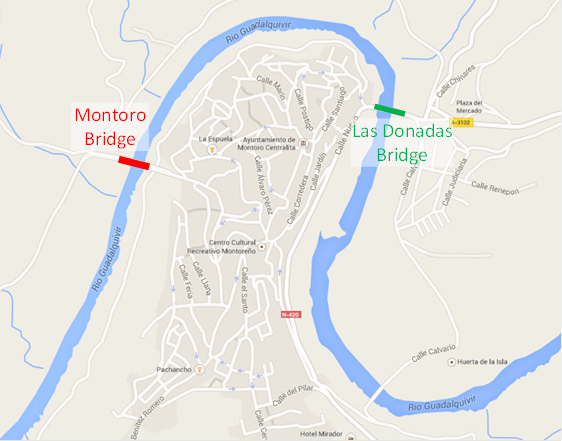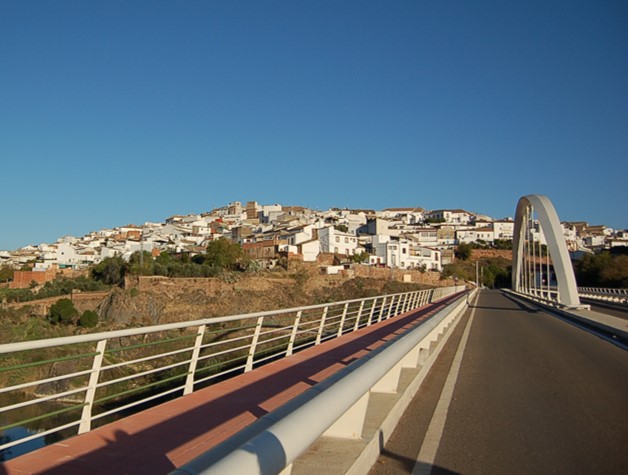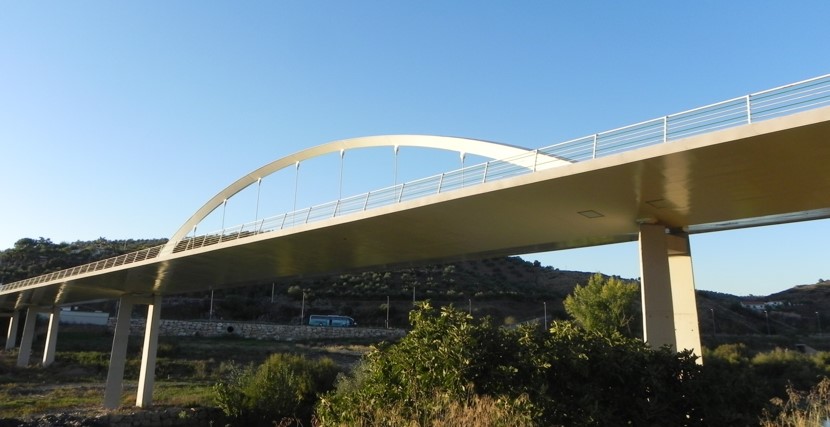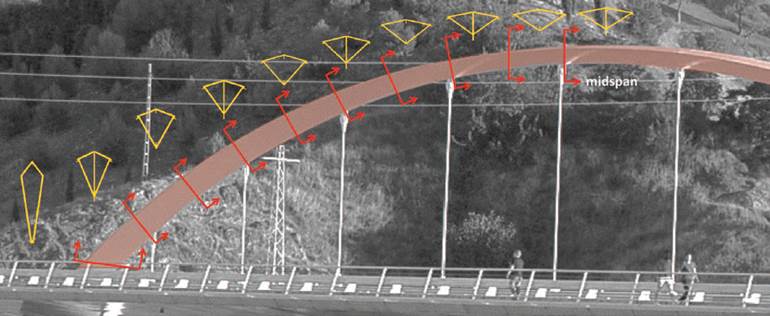Figure 1: Montoro Bridge in Montoro (Córdoba), Andalusia, Spain. Photo: Álvarez et al. [4].
Design engineer: José Romo-Martín (FHECOR Ingenieros Consultores)
Owner: Junta de Andalucía
Contractor: Joint venture Tapusa – Construcciones Vera
Built: 2007 - 2009
Main span: 60 meters (197 feet)
Total length: 200 meters (656 feet)
Structural system: Tied arch (bowstring)
Introduction
Located in the heart of Córdoba Province in southern Spain, the Puente Nuevo de Montoro is a modern example of Structural Art. Financed by the Andalusian government, the bridge was designed by the Spanish engineer Jose Romo from the firm FHECOR Ingenieros Consultores. The bridge connects the town of Montoro to the countryside and fields to the West. To do this, the bridge carries the Calle Pescadores- literally the Fisherman’s Street- across a length of 200 meters of river and flood plain with a beautifully thin deck and arch. In doing so, the Puente Nuevo exemplifies the use of modern engineering practices and materials.
The bridge is composed of six spans with a total of 200 m. The longest span of 60 meters is supported by an overhead arch tied to the deck through steel hangers (Figure 2). The deck itself is a composite box girder with a pseudo-triangular cross section. The spans are supported by piers in the middle and abutments at the ends. The piers are framed structures to maximize lateral support and stability.

Figure 2: Elevation of the Montoro Bridge showing the Guadalquivir River and olive tree fields in the background. Photo: J. Romo.
The town of Montoro is nestled in an elbow of the snaking Guadalquivir River (Figure 3). For centuries, this river served as both a boon and hindrance for travel. It has allowed shipping and navigation through the region but has prevented foot traffic at many points owing to a lack of permanent bridges. Over the past 50 years, the governments have sponsored a series of public works projects to solve this problem. These bridges and projects showcase the evolution of civil bridge design as well as the impact that bridges can have on connecting people and land. This makes the Montoro Bridge an interesting and enlightening study from a technical as well as social and symbolic perspective.

Figure 3: City of Montoro showing the location of the bridge. Source: Google Maps.
Justification of the bridge
The Montoro Bridge creates a new access to the Western part of Montoro’s old town. Before the new bridge was built, there was only a bridge in the town crossing the Guadalquivir River: Las Donadas Bridge (see Figure 3) which had been built at the end of the 15th century. Therefore all the urban traffic from the Western part of the town getting out from Montoro had use the town intricate streets [1, 2]. The new bridge solved this problem and created a new connection to the land to the West. This connection is very used by both motor vehicles and pedestrians who can enjoy a promenade with very nice views over the town and the countryside. These facts were confirmed by several pedestrians that were interviewed during the class visit to the bridge.

Figure 4: The Montoro Bridge has wide sidewalks that create a promenade with spectacular views over Montoro’s Old Town and the countryside. Source: Álvarez et al. [4].
Flow of forces in the main span
The Montoro Bridge has a continuous deck whose main span is supported by an arch. The flow of forces in the main span is shown in Figure 5 and is as follows:
- The load (e.g. self-weight and vehicles) acts on the deck, which in turn transfers the load to the hangers.
- The hangers carry the load to the arch.
- The arch carries the load to the supports, where there is a vertical and horizontal component of forces due to the inclination of the arch.
- The supports carry the vertical load to the ground.
- The 60 meter main span deck resists the horizontal component of the support reaction by being in tension between supports.

Figure 5: Flow of forces in the main span of Montoro Bridge. Image: M. Garlock based on photograph by J. Glassman.
Special features of the design
Montoro Bridge represents the evolution of the arch bridge over a time period that is representative of the history of civil engineering. According to Jose Romo [3], the structural engineer of the bridge, the arch bridge has a strong presence in Southern Spain . The oldest bridges in the region are old Roman bridges. They use series of stone arches to cross the rivers. The fact that many of them still stand today is a testament to enduring engineering methods and design. Many of the early modern bridges in the region chose to imitate and pay homage to their Roman ancestors and use masonry arches as structural system. The Montoro Bridge represents the modern evolution of the arch bridge and its more representative features of its design are explained below.
The cross section of the arch is the first element that deserves special attention (see Figure 6). This section is made of four steel plates and its total area stays constant throughout the entire arch but its shape changes [1]. At the base of the arch, the arch is a thin and elongated diamond. The purpose of this was to decrease the width of the arch on the deck to reduce the interference with the roadway. At the crown of the arch, the area remained the same to carry all the compressive forces but the shape is a wider and flatter diamond to give the arch more stiffness to prevent the arch out of plane buckling.
Figure 6: Change in shape of the cross sections of the arch. Image: M. Garlock based on photograph by J. Glassman.
The deck is another element of the bridge that deserves attention (Figure 7 and 8). Its pseudo-triangular shape was chosen to emphasize the slenderness and lightness of the bridge but it also provides the torsional stiffness required by the design decision of placing the arch in the longitudinal axis of the deck [1].

Figure 7: View of the bridge showing is slender deck. Image: I. Payá-Zaforteza.

Figure 8: Cross section of the bridge showing its slender deck and the arch. Source: J. Romo.
Finally, the piers are another important element of the bridge design (Figure 8). They have two slender legs with a triangular cross-section that tapers from the bottom to the top. A horizontal member connects the legs. This member: (1) ensures that the legs act together when taking the lateral forces allowing the bridge to resist transverse loads due, for example, to wind or floods, (2) makes the two legs work as a rigid frame which increases its buckling strength. Apart from having structural significance, the triangular cross-section of the legs serves is important for the aesthetics of the bridge as well. J. Romo talked about how the triangular design was chosen to compliment the nearly triangular cross-section of the deck [3].

Figure 8. View of the bridge piers. Source: Álvarez et al. [4].
Conclusion
The Montoro Bridge is a modern rendition of a classic form. It connects the sleepy town of Montoro to the neighboring fields and creates a needed new way to the Western part of the town. To do this, its slender deck transverses 200 meters of open air with the help of an arch in the main span and creates an elegant design that pays homage to the tradition of bridge design in southern Spain.
References
[1] J. Romo Martín and G. de Canales Torralbo. “Nuevo puente sobre el Guadalquivir, en Montoro (Córdoba). Carácter lineal.” Revista Cauce 2000 : 74-79. In Spanish.
[2] J. Romo Martín and J. Soriano Martín. “Puente sobre el río Guadalquivir en Montoro (Córdoba).” Actas del V Congreso de la Asociación Científico-Técnica del Hormigón Estructural (Ache), Barcelona, Spain, 2010. In Spanish.
[3] J. Romo Martín. Interview conducted by J. Álvarez, R. Archer and S. Coffers at Princeton University, October 14th, 2014.
[4] J. Álvarez, R. Archer and S. Coffers. “Montoro Bridge.” Report submitted for the fulfillment of the requirements of the course “CEE 463. A Social and Multi-Dimensional Exploration of Structures,” Princeton University, 2015.

